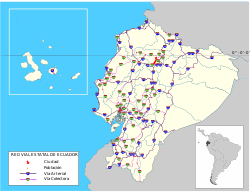HD 48265
HD 48265| 관찰 데이터 Epoch J2000 Equinox J2000 | |
|---|---|
| 콘스텔레이션 | 퍼피스 |
| 적경 | 06h 40m 01.7270s[1] |
| 적위 | - 48° 32° 31.042°[1] |
| 겉보기 등급(V) | 8.07[2] |
| 특성. | |
| 스펙트럼형 | G5IV/V[3] |
| 겉보기 등급(B) | 최대 8.80[2] |
| 겉보기 등급(J) | 6.842 ± 0.021[4] |
| 겉보기 등급(H) | 6.529 ± 0.061[4] |
| 겉보기 등급(K) | 6.449 ± 0.020[4] |
| 아스트로메트리 | |
| 반지름 속도(Rv) | 22.5 ± 0.2[5] km/s |
| 고유운동(μ) | RA:26.524±0.089mas[1]/년 Dec.:29.689±0.095mas[1]/년 |
| 시차()) | 11.14 ± 0.21 mas[1] |
| 거리 | 293 ± 6y (90 ± 2 pc) |
| 절대 등급(MV) | 3.34[6] |
| 세부 사항 | |
| 덩어리 | 0.93[6] M☉ |
| 반지름 | 2.34 ± 0.26[7] R☉ |
| 광도 | 0.623 ± 0.058[7] L☉ |
| 온도 | 5,508[5] K |
| 금속성 [Fe/H] | 0.29 ± 0.05[2] 덱스 |
| 회전 속도(v sin i) | 3.0[7] km/s |
| 나이 | 4.8[5] Gyr |
| 기타 명칭 | |
| 데이터베이스 참조 | |
| 심바디 | 데이터. |
| 외계 행성 기록 보관소 | 데이터. |
| 외계 행성 백과사전 | 데이터. |
HD 48265는 남쪽 꼭두각시자리에 있는 별에 대한 헨리 드레이퍼 목록입니다.겉보기 등급은 8.07로 [2]육안으로 볼 수 없을 정도로 어둡다.히파르코스 임무 중 시차 측정치에 따르면 이 행성은 지구에서 [1]약 293광년(90파섹) 떨어진 곳에 위치해 있다.
이 별의 분광형은 G5IV/[3]V로, 나이는 48억 [5]년으로 주계열성과 준거성 사이의 중간 진화 단계에 도달했음을 시사합니다.이 [6]행성의 질량은 태양의 93%에 불과하지만, 외부 대기는 팽창하기 시작해 태양 [7]반지름의 약 2.3배에 달합니다.HD 48265는 유효 온도 5,508 [5]K에서 태양 광도의 62%[7]를 방출하여 K형 [9]별의 차가운 주황색 빛을 냅니다.이 별의 화학적 함량을 측정한 결과, 태양에 비해 수소와 헬륨을 제외한 원소 비율이 95% [2]더 높은 것으로 밝혀졌는데, 이는 천문학자들이 이 별의 금속성이라고 부르는 것입니다.
행성계
2008년 10월 행성 HD 48265 b가 이 별 주위를 돌고 있는 것으로 보고되었다.이 물체는 6.5m 마젤란 II([6]클레이) 망원경의 MIKE 에셸 분광기를 사용하여 마젤란 행성 탐사 프로그램에서 수행한 천문학적 조사에서 반경 속도법을 사용하여 발견되었다.
| 동반자 (별부터 순서대로) | 덩어리 | 세미마조르 축 (AU) | 공전 주기 (일) | 편심 | 기울기 | 반지름 |
|---|---|---|---|---|---|---|
| b | 1.47±0.12 이하 MJ | 1.81±0.07 | 780.3±4.6 | 0.08±0.05 | — | — |
IAU의 [11][12]NameExoWorlds 프로젝트의 일환으로 온라인 여론조사에서 아르헨티나 유권자들이 투표한 바와 같이 HD 48265 b는 Moqoit 언어로 Naqaaa(형제)와 HD 48265 Nosaxa(봄철)로 명명되었습니다.
「 」를 참조해 주세요.
레퍼런스
- ^ a b c d e f Brown, A. G. A; et al. (2016), "Gaia Data Release 1. Summary of the astrometric, photometric, and survey properties", Astronomy and Astrophysics, 595, A2, arXiv:1609.04172, Bibcode:2016A&A...595A...2G, doi:10.1051/0004-6361/201629512, S2CID 1828208Gaia Data Release 1 카탈로그 엔트리
- ^ a b c d e Jenkins, J. S.; et al. (July 2008), "Metallicities and activities of southern stars", Astronomy and Astrophysics, 485 (2): 571–584, arXiv:0804.1128, Bibcode:2008A&A...485..571J, doi:10.1051/0004-6361:20078611, S2CID 8813298
- ^ a b Houk, Nancy (1978), Michigan catalogue of two-dimensional spectral types for the HD stars, vol. 2, Ann Arbor: Dept. of Astronomy, University of Michigan, Bibcode:1978mcts.book.....H
- ^ a b c Cutri, R. M.; et al. (June 2003), 2MASS All Sky Catalog of point sources, NASA/IPAC, Bibcode:2003tmc..book.....C
- ^ a b c d e Nordström, B.; et al. (May 2004), "The Geneva-Copenhagen survey of the Solar neighbourhood. Ages, metallicities, and kinematic properties of ˜14 000 F and G dwarfs", Astronomy and Astrophysics, 418: 989–1019, arXiv:astro-ph/0405198, Bibcode:2004A&A...418..989N, doi:10.1051/0004-6361:20035959, S2CID 11027621
- ^ a b c d Minniti, Dante; et al. (2009), "Low-Mass Companions for Five Solar-Type Stars From the Magellan Planet Search Program", The Astrophysical Journal, 693 (2): 1424–1430, arXiv:0810.5348, Bibcode:2009ApJ...693.1424M, doi:10.1088/0004-637X/693/2/1424, S2CID 119224845
- ^ a b c d e "HD 48265", NASA Exoplanet Archive, NASA, retrieved 2012-03-15[영구 데드링크]
- ^ "HD 48265". SIMBAD. Centre de données astronomiques de Strasbourg. Retrieved 2012-03-15.
- ^ "The Colour of Stars", Australia Telescope, Outreach and Education, Commonwealth Scientific and Industrial Research Organisation, December 21, 2004, archived from the original on March 10, 2012, retrieved 2012-01-16
- ^ Jenkins, J. S.; et al. (2017), "New planetary systems from the Calan–Hertfordshire Extrasolar Planet Search", Monthly Notices of the Royal Astronomical Society, 466 (1): 443–473, arXiv:1603.09391, Bibcode:2017MNRAS.466..443J, doi:10.1093/mnras/stw2811, S2CID 18016219
- ^ "Argentina", NameExoworlds, retrieved 2019-12-18
- ^ Javier Salas (2019-12-20), "Rosalía de Castro ya tiene su estrella", El País, retrieved 2020-01-06
외부 링크
- "HD 48265". Exoplanets. Archived from the original on 2016-03-03. Retrieved 2009-06-10.


